Structure and physiological function of the nose
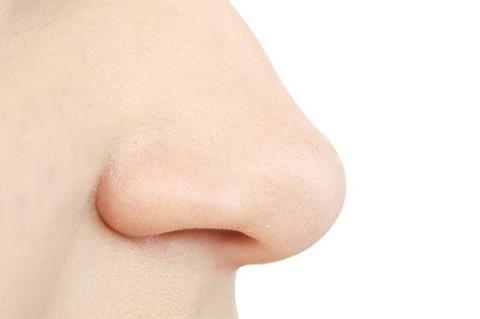
The nose is an important organ and has a complex structure. The nose is the first part of the respiratory system. It is responsible for conducting, warming, humidifying and filtering the air that passes through the nose before moving further into the respiratory system. The nose is also the olfactory organ responsible for the sense of smell. At the moment of breathing, air enters through the nostrils to the nasal cavity, continuing to pass through the pharynx, trachea, bronchi, and finally the lungs. The structure and physiological function of the nose will be described in detail in the following article.
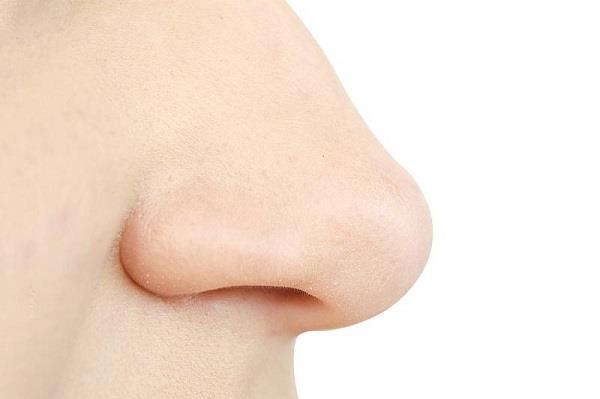
content
1. Structure of the nose
The nose consists of three parts: the outer nose, the inner nose, and the paranasal sinuses.
1.1 Outer nose
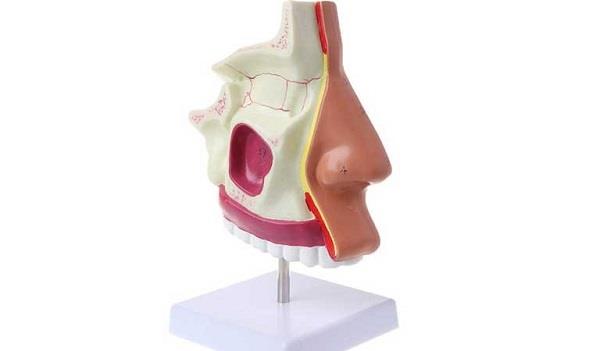
The external nose consists of a cartilaginous skeleton lined by mucosa, the components that cover the muscles, and the skin. Thanks to the cartilage, the outer nose does not collapse, ensuring air circulation through the nasal cavity.
The outer nose has a pyramid-shaped structure, the base of the nose is located above, between the eyes, connected to the forehead, continuous with the tip of the nose. The distance from the base of the nose to the tip of the nose is the nose bridge (or bridge of the nose).
Below the tip of the nose are two anterior nostrils separated from each other by the movable part of the nostrils. Outside the nostrils is the wing of the nose that makes a groove with the cheeks called the nasolabial fold.
a. Cartilaginous skeleton of the nose
The supporting structure of the upper part of the nose is mostly made of bone. The nose has two nasal bones, which are related to the frontal bone of the forehead.
These nasal bones come together to form the bridge of the nose. The nasal bones are usually oblong, long, small, of different sizes and shapes.
The nasal bone is usually divided into two symmetrical parts in the middle of the face.
The nasal bone includes parts such as:
-
Skeletal surface: The outer surface is usually convex and covered by the nasal muscles. Inside there is a small groove containing the veins.
-
Couplings: The nasal bones have four joints that connect the parts of the nose.
b. Nasal cartilage
The nasal cartilage supports the structure and function of the nose.
Nasal cartilage is usually composed of Collagen, Protein and some other components.
Nasal cartilage includes:
-
The two lateral nasal cartilages have a triangular, flat structure and are located below the nasal bones.
-
The alar cartilage is large, located on both sides of the top of the nose, curved in the shape of a U.
-
The small nasal cartilage is located in the medial cavity, which connects the large alar cartilage with the lateral nasal cartilage.
-
The quadrangular nasal septum is located on the midline in the triangular medial space of the bony nasal septum, which connects the nasal bone with the lateral cartilage.
-
Cane leaf cartilage connects the septum and the thin bones separating the nostrils.
c. Muscles of the external nose
These muscles are the muscles that attach to the skin, helping to widen and narrow the nose.
d. Nose skin
Properties: thin, easy to move, sticky, with many sebaceous glands. Except at the tip of the nose and the cartilages, the skin is thick.
e. There are also blood vessels and nerves.
1.2 Inner nose
The inner nose (or alveolar cavity) is the part starting from the anterior nostril to the posterior nostril. Divided into two pits with a septum in the middle called the nasal septum, lined by mucosal layers. The nasal cavity is divided into two specific regions: the respiratory region and the olfactory region.
a. Nose vestibule
This is the first part of the nasal cavity, which corresponds to the cartilaginous part of the external nose. The nasal vestibule is lined with skin, hair follicles, and several sebaceous glands. This area usually contains many microchips.
b. Nasal cavity
The nasal cavity is a large space inside the nose. The compartments are divided into 2 specific parts by baffles. This division helps the nose to properly perform the functions of smell and air conditioning.
The nasal cavities are lined with respiratory mucosal epithelium. There are many nasal hairs and mucous glands, which are responsible for maintaining moisture, blocking dust, and protecting the nose from allergens and irritants from the environment.
c. Nasal septum
The nasal septum is a straight piece of bone, the front part is the cartilage of the nasal septum and the lower part is the cane bone.
Simply put, the nasal bone can be felt in the middle of the eyelid, the cartilage extending from the tip of the nose to the middle. The nasal septum divides the nostrils, continuing with the nasal cavity. The mucosa covers the entire nasal septum in the vestibule.
d. Nose socket background
The base of the nasal cavity (or roof of the mouth) is formed by the palatal processes of the maxilla and the transverse fragments of the palatine bone. The base of the nose is usually about 5 cm wide and usually passes through the sensory nerves of the olfactory system. Covered by mucous membranes.
e. Posterior nostrils
At the back of the nasal cavity there are two openings called posterior nostrils. The posterior nostril is responsible for bringing air into the nasopharynx and the rest of the respiratory system.
f. Nasal valve:
The nasal valve ensures temperature, humidity (water saturation up to 98%) and filters the air as it moves to the nasal cavity.
The nasal valve is the narrowest passage of the airways. The external nasal valve is usually larger than the intraseptal nasal valve.
g. Drainage into the nasal cavity:
The airway epithelium that connects the sinuses is firmly attached to the underlying membrane of the nose. In each paranasal sinus there is a small opening that allows drainage into the nasal cavity.
1.3 Sinus
The paranasal sinuses are hollow cavities in the bones of the nasal wall. The walls of the sinuses are lined with mucosa (similar to the nasal cavity), with ciliated hair cells that always vibrate in one direction, sweeping mucus into the nose. Therefore, normally the sinuses are empty, airy and dry.
There are four groups of sinuses, frontal sinuses, ethmoid sinuses, maxillary sinuses, and sphenoid sinuses.
An abnormality in any of the sinuses causes sinus problems.
The sinuses are responsible for resonating sound, moistening the nasal mucosa, and warming the air. In addition, it also lightens the weight of the facial bones.
1.4. Muscles in the nose
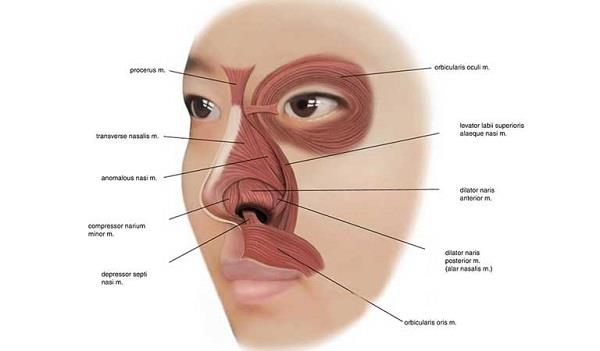
Nasal movements are controlled by groups of facial and neck muscles deep within the skin. There are 4 groups of muscles that are linked together and are responsible for the actions of the nose. Some people are able to use these muscles to close their nostrils and prevent water from entering while in the water.
1.5 Mucosal
a. Mucosa
The inner lining of the nasal cavity is the nasal mucosa. Divided into 2 regions:
- The small area above the olfactory nerve fibers is called the olfactory zone. If the infection is in this area, it is easy to follow the olfactory nerves up to the meninges.
- The flow of air breathed through the nostrils will be in two directions: according to the upper channel into the olfactory area - according to the middle and lower niches is the breath.
- The large area below is the respiratory zone. In this area, the mucosa is red and pink, often with many mucosal glands secreting a viscous substance with dust that dries into nasal scales.
b. Nose hair
Hair is present in the nostrils, which play an important role in filtering and humidifying the air in the atmosphere. Nose hairs serve as a defense mechanism against pathogens, removing toxic solid materials and airborne particles.
Both the nostrils and the nasal cavity are lined by mucous membranes, cilia. The membrane secretes a sticky substance called mucus. This mucus and cilia help filter the air, preventing foreign invaders such as microorganisms, dust particles. Mucus also helps to humidify the air. Beneath the mucous membranes, there are blood capillaries that heat the air to match body temperature.
c. Blood vessel:
Beneath the mucosal epithelium is surrounded by dense lymphatic cells and blood vessels, called the venous plexus. It has the effect of warming the air before it enters the lungs. Therefore, when these plexuses are damaged, the patient often bleeds profusely (nosebleeds).
2. Function of the nose
2.1 Respiration
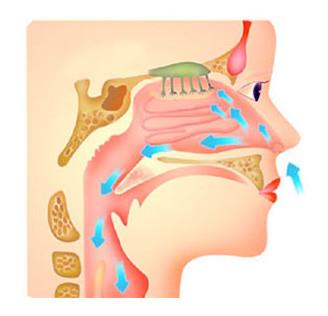
The main function of the nose is to supply and regulate air into the rest of the respiratory system. Normal ventilation is a necessary condition for the normal functioning of respiration.
The nose warms, humidifies and cleans the air thanks to the nasal mucosa, a network of blood vessels. Dust, bacteria, and small foreign bodies are retained in the nasal vestibule by nasal hairs and mucus. These substances fall into the throat and are swallowed or spit out. The hair cells move at a rate of 400 to 800 beats per minute. The air entering the lungs is significantly purified. If you breathe through the mouth, the foreign objects will go straight into the throat, larynx, trachea, bronchi and easily cause disease.
The cell system in the submucosa, produces phagocytes and immune fluids such as IgE, IgG, IgA, IgM...
In addition, nasal breathing also has the effect of creating a negative pressure in the lower respiratory tract. This phenomenon ensures good ventilation of the lungs and intake of a larger volume of oxygen than when breathing through the mouth.
Complete or partial obstruction of the nose can lead to a number of diseases of the respiratory tract such as pharyngitis, tracheitis, bronchiolitis, etc.
2.2 Sense of smell
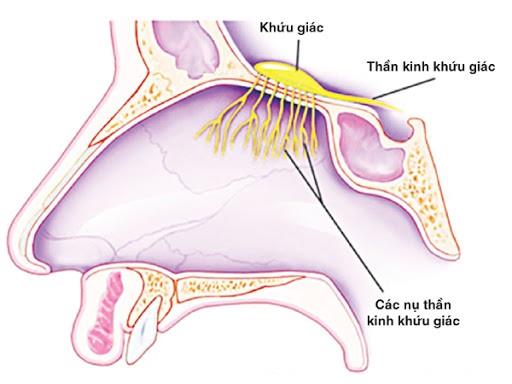
The nose also plays a major role in the olfactory system . The nose is the region of the olfactory nerve cells and is responsible for the human perception of smell.
The olfactory function is performed by the olfactory mucosa in the upper chamber containing the olfactory glands and sensory neurons, with an area of 2-3 cm2.
The mucosa in this area is brick red, thin, with few glands, few blood vessels, few glandular hairs.
Odors dissolve in the mucous membrane on the sensory cells, causing stimulation to the olfactory nerve. Nerve cells are shaped like cilia. Normally, each person has about 1 billion olfactory cells. Therefore, the contact area of odor molecules with the olfactory cells is about 500 - 700 cm2. This helps humans have a relatively sensitive sense of smell and distinguish many different odors.
The olfactory cells are responsible for transferring those stimuli to the olfactory bulb. In the olfactory bulb there are intermediate cells that transmit impulses through the olfactory bulb and to the olfactory centers in the cerebral cortex. These centers are responsible for analyzing odors.
The sense of smell is an instinctive, long-lasting, reminiscent sense that people call habituation.
The nose is very vulnerable to damage and dysfunction of the sense of smell. Nasal congestion greatly affects the perception of odors.
In addition, the sense of smell stimulates reflexes to secrete saliva and gastric juices.
2.3 Pronunciation function
Speech is usually produced by pressure from the lungs. However, some people can produce speech using air from the nose, called nasal sounds.
The nasal cavity produces nasal voices and absorbs air vibrations during vocalization and converts it into stimuli that govern the coordination of pharyngeal and laryngeal muscles, which play an important role in pronunciation.
To make sounds from the nose, you need to lower the roof of your mouth to let out the vowels and consonants by allowing air to escape from the mouth and nose.
The nose has an impact on the voice, creating the distinct timbre and reverberation of each person. When the nasal cavity is closed or the posterior or anterior nostrils are closed, the voice loses its resonance and changes in timbre, which is called a closed nasal voice.
In a nutshell, the nose is responsible for breathing, olfactory perception, and pronunciation. If infected, stuffy nose will affect the normal function of the nose. Clean the nose by using a soft cloth to wipe, do not try to wipe the nasal cavity, use nasal drops to clean the nasal discharge. Do not suck your nose too often, it will affect the nasal membranes, cause bleeding, or cause the nasal cavity to swell. Please protect and take care of the nose area gently and properly.
>> Nose is an important and prominent part of each person's face. The nose has many respiratory functions as well as aesthetics. This is also an easily injured part in everyday accidents. Nasal fractures are the most common fractures of the bones in the maxillofacial region.
Doctor Doan Thi Hoai Trang